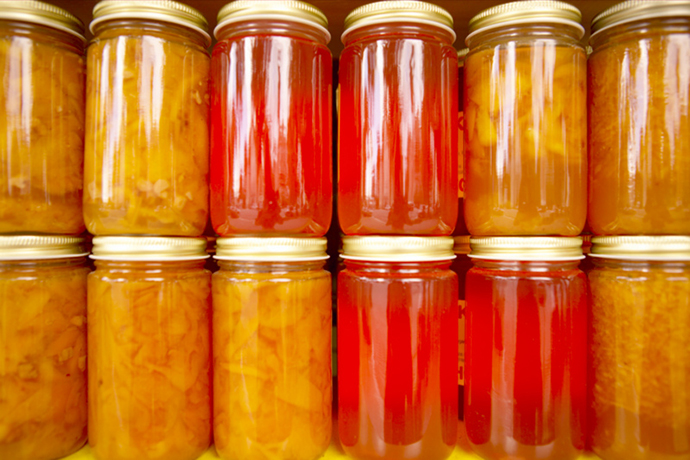Ask a Specialist: Safety First When Canning Garden Produce
 Food preservation questions arise every year as gardeners harvest produce and preserve it for food storage. In response to the most frequently asked questions, the National Center for Home Food Preservation (NCHFP) offers the following tips and advice.
Food preservation questions arise every year as gardeners harvest produce and preserve it for food storage. In response to the most frequently asked questions, the National Center for Home Food Preservation (NCHFP) offers the following tips and advice.
Is it necessary to sterilize jars before canning?
Jars do not need to be sterilized before canning if they will be filled with food and processed in a boiling water bath canner for 10 minutes or more or if they will be processed in a pressure canner. Filled jars that will be processed in a boiling water bath canner for less than 10 minutes need to be sterilized first. Boil the jars in hot water for 10 minutes before they're filled. Note that there are no boiling water bath recipes at our altitudes with processing times of 10 minutes or less.
Do I really need to leave a certain amount of headspace in the jar?
Yes. Leaving the specified amount of headspace in a jar is important to assure a vacuum seal. If too little headspace is allowed, the food may expand and bubble out when air is being forced out from under the lid during processing. The bubbling food may leave a deposit on the rim of the jar or the seal of the lid and prevent the jar from sealing properly. If too much headspace is allowed, the food at the top is likely to discolor. Also, the jar may not seal properly because there will not be enough processing time to drive all the air out of the jar.
Can two layers of jars be processed in a canner at one time?
Yes. Two layers can be processed at one time, in either the boiling water bath or pressure canner. Place a small wire rack between the layers so water or steam will circulate around each jar. Make certain the water covers the tops of all jars by 1 inch in a boiling water bath canner. The pressure canner should have 2 to 3 inches of water in the bottom.
Is it okay to reuse jar fittings (lids and bands)?
Lids should not be used a second time since the sealing compound becomes indented by the first use, preventing another airtight seal. Screw bands may be reused unless they are badly rusted or the top edge is pried up, which would prevent a proper seal.
What causes jars to break in a canner?
Breakage can occur for several reasons, including using commercial food jars rather than jars manufactured for home canning, using jars that have hairline cracks, putting jars directly on the bottom of the canner instead of on a rack, putting hot food in cold jars or putting jars of raw or unheated food directly into boiling water in the canner, rather than into hot water. This causes a sudden change in temperature, which is too wide a margin between the temperature of filled jars and water in the canner before processing.
What can I process in half-gallon canning jars?
At least one canning jar manufacturer is selling half-gallon canning jars. That manufacturer has a printed note on the top that says half-gallon jars are only to be used for highly acidic foods in a boiling water canner, with instructions to call a toll-free number for processing information. The only recommended choices are grape juice and apple juice.
Why is canning summer squash or zucchini not recommended?
Recommendations for canning summer squashes, including zucchini, have been withdrawn due to uncertainty about the determination of processing times. Squashes are low-acid vegetables and require pressure canning for a known period of time that will destroy the bacteria that cause botulism. Documentation for the previous processing times cannot be found, and reports that are available do not support the old process. Slices or cubes of cooked summer squash will get quite soft and pack tightly into the jars. The amount of squash filled into a jar will affect the heating pattern in that jar. It is best to freeze summer squashes or pickle them for canning. They may also be dried.
Can I can my own salsa recipe?
No. Salsas are usually mixtures of acid and low-acid ingredients; they are an example of an acidified food. The specific recipe, and sometimes preparation method, will determine if a salsa can be processed in a boiling water canner or a pressure canner. A process must be scientifically determined for each recipe. To can salsa at home, use a USDA, NCHFP or other tested recipe. Your county Extension agent may have additional tested recipes for salsas.
Along with using up-to-date canning guidelines, scientifically tested recipes, adjusting for altitude and using recommended canning equipment that is in good working condition, additional safety precautions should be taken.
When a kitchen turns into a home canning laboratory, those participating in the canning need to become dedicated scientists willing to pay attention to small details. Just as a scientist makes certain the ingredients for a research project are measured properly and monitored throughout the experiment, the home canner must be willing to minimize distractions and stay focused on the canning process — especially when pressure canning. Why are there horror stories of canners exploding or melting onto the burners of the range? Mainly, it is due to neglect and failure to regularly monitor the process.
For additional information, contact your local USU Extension office or visit http://nchfp.uga.edu.
By Kathy Riggs, Utah State University Extension professor, kathleen.riggs@usu.edu, 435-586-8132
What Next?
Get useful tips like this as soon as we release them. Sign up here.


 Utah 4-H & Youth
Utah 4-H & Youth